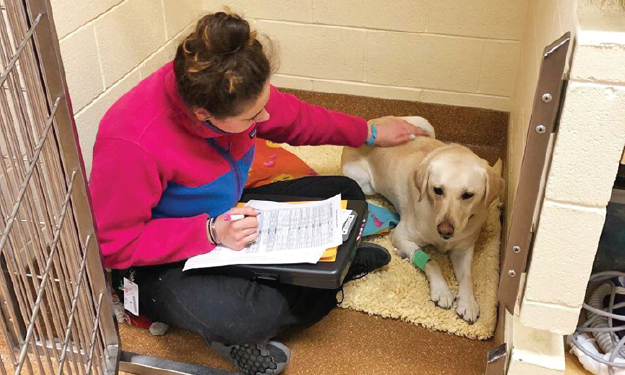TPLO Cruciate Repair

Cranial cruciate ligament rupture (CCLR) is the most common orthopedic injury in dogs. In people, the same ligament is called the anterior cruciate ligament. In both species the ligament may stretch or tear, leading to pain and osteoarthritis. CCLR can make the menisci vulnerable to tearing, which is quite painful. The menisci are two small cushions of fibrocartilage that sit between the bones of the knee.
The signs of CCLR vary, but they include an acute onset of lameness followed by mild improvement but continued lameness. Other dogs experience a moderately progressive lameness particularly associated with exercise or lameness when the dog gets up after resting.
Diagnosis
CCLR is first diagnosed by palpation (examination and manipulation by hand). X-rays are routinely taken in dogs with CCLR, but this disease cannot be diagnosed on x-rays because the ligament does not appear on radiographs.
Treatment
Surgery is recommended for most dogs with CCLR. In very small dogs it is possible for the knee to improve in stability without surgery as the body lays down scar tissue, but in most dogs adequate stabilization of the knee will usually not be achieved, and the pain and lameness will continue.
More traditional surgical treatments of CCLR involve replacing of the ligament with either a natural or synthetic material. In these procedures, natural fibrous tissue, nylon suture, or wire is used to stabilize the knee. These procedures have been used for more than half a century, and the results are good in many cases. The main concern with these procedures is that the stabilizing material can stretch or break, after which the knee is stabilized by scar tissue. This may lead to a decrease in the range of motion of the joint. We recommend extracapsular suture surgery for smaller dogs (less than 35 pounds) or when medical or financial limitations prohibit performance of a Tibial Plateau Leveling Osteotomy (TPLO).
Tibial Plateau Leveling Osteotomy
The most widely used technique in treatment of CCLR by board certified surgeons is the TPLO. In this technique, the lower bone of the joint (tibia) is cut and rotated to eliminate the abnormal motion of the knee during normal activity. The advantage of this procedure is that it does not rely on materials that can stretch or break to stabilize the knee. We recommend TPLO in most of our medium and large patients and particularly in more active dogs.
How the TPLO Works
Studied have demonstrated that if the lower bone of the knee (the tibia) is steeply sloped at the level of the joint, the upper bone of the knee (the femur) is always sliding down the tibia. This constant sliding places strain on the cruciate ligament, possibly causing it to fail. The TPLO procedure corrects the tibial plateau angle to eliminate the sliding and the instability of the knee and the accompanying pain and slowing the progression of osteoarthritis.